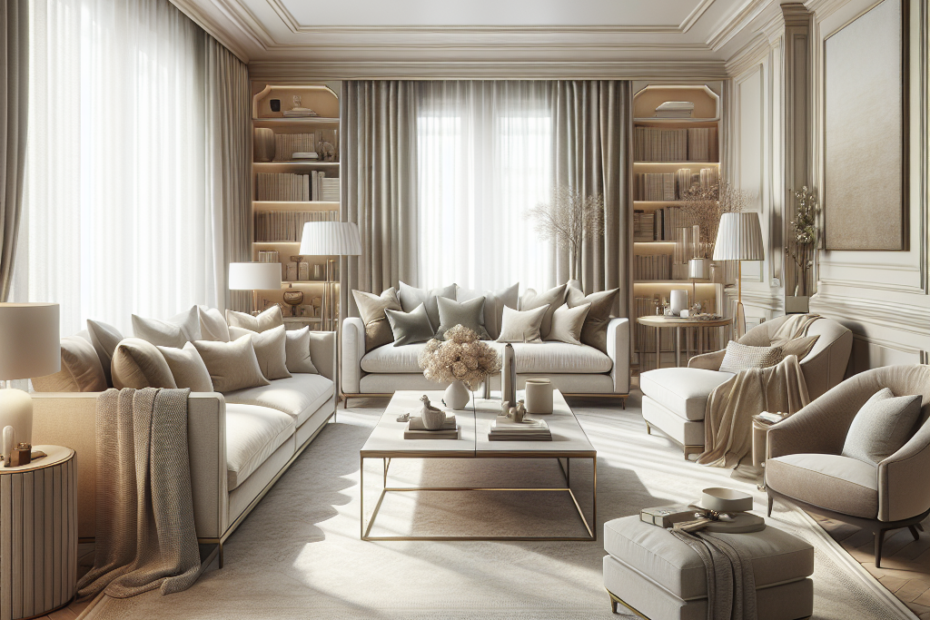“`html
The Power of Neutral Palettes in Living Room Design
When people think about redecorating their living rooms, they often consider trendy colors and bold patterns. However, there’s a timeless option they might be overlooking: neutral palettes. Neutral living room palettes may seem understated at first, but they offer incredible versatility and elegance that can transform any space into a sanctuary of calm and sophistication.
Why Choose Neutral Palettes?
Neutral colors like whites, beiges, grays, and soft earthy tones are more than just safe choices. They serve as a canvas that allows other elements in the room to shine. According to a study by the American Society of Interior Designers (ASID), 60% of people prefer neutral colors in their homes because they are timeless and versatile (ASID).
Transforming Spaces with Neutral Colors
Neutral living room palettes can make a space feel larger, cleaner, and more inviting. By using gentle tones and textures, homeowners can create a backdrop that enhances natural light and accentuates their furniture and decor.
Benefits of Neutral Living Room Palettes
There are several advantages to using a neutral palette in the living room:
- Timeless Appeal: Neutral colors never go out of style, making them a safe investment.
- Versatility: They can easily be updated with seasonal accent colors and decor items.
- Eases Stress: Neutral tones create a calming environment that promotes relaxation.
- Highlighting: Bold art pieces and statement furniture pop against a neutral background.
- Resale Value: Homes with neutral interiors are more appealing to prospective buyers.
Neutral Palette Inspirations
Homeowners can draw inspiration from various sources when choosing their neutral palette. Popular choices include:
| Palette Type | Colors Involved | Best For |
|---|---|---|
| Scandinavian | Whites, light grays, and natural wood tones | Minimalist and modern spaces |
| Farmhouse | Beiges, creams, soft greens, and rustic wood tones | Cozy and rustic aesthetics |
| Industrial | Steel grays, matte blacks, and exposed brick tones | Urban and edgy environments |
Implementing Neutral Palettes
Using neutral colors requires careful planning to avoid making spaces feel too bland. Here are some tips to keep in mind:
- Texture Variety: Use different textures like wool, velvet, and linen to add depth.
- Layering: Layering rugs, throw pillows, and blankets can make a space feel cozier.
- Natural Elements: Incorporating plants and natural wood can break up the monotony of neutral tones.
- Accent Colors: Adding a pop of color through decor items like vases and art can bring life to neutrals.
Real-Life Examples
Many interior designers successfully use neutral living room palettes to create stunning interiors. For instance, Joanna Gaines—known for her modern farmhouse style—frequently uses whites and natural wood tones in her designs. According to an analysis by Zillow, homes with light neutral interiors sell for 2-3% more than those with bold colors (Zillow).
Key Takeaways
In summary, neutral living room palettes offer timeless elegance, versatility, and the ability to create a calming environment. By carefully planning textures, layers, and accent colors, homeowners can make their living rooms both stylish and comfortable.
FAQ
- Q1: What are neutral colors?
- A: Neutral colors include shades like white, beige, gray, and soft earthy tones.
- Q2: Why are neutral palettes popular in living room design?
- A: Neutral palettes are popular because they are versatile, timeless, and create a calming environment.
- Q3: How can I prevent a neutral palette from looking bland?
- A: Use different textures, layering, natural elements, and accent colors to add depth and interest.
- Q4: Are neutral palettes good for home resale value?
- A: Yes, homes with neutral interiors are generally more appealing to buyers and can sell for higher prices.
- Q5: Can neutral palettes work in any design style?
- A: Yes, neutral palettes are very versatile and can be adapted to various design styles, from minimalist to rustic.
“`
